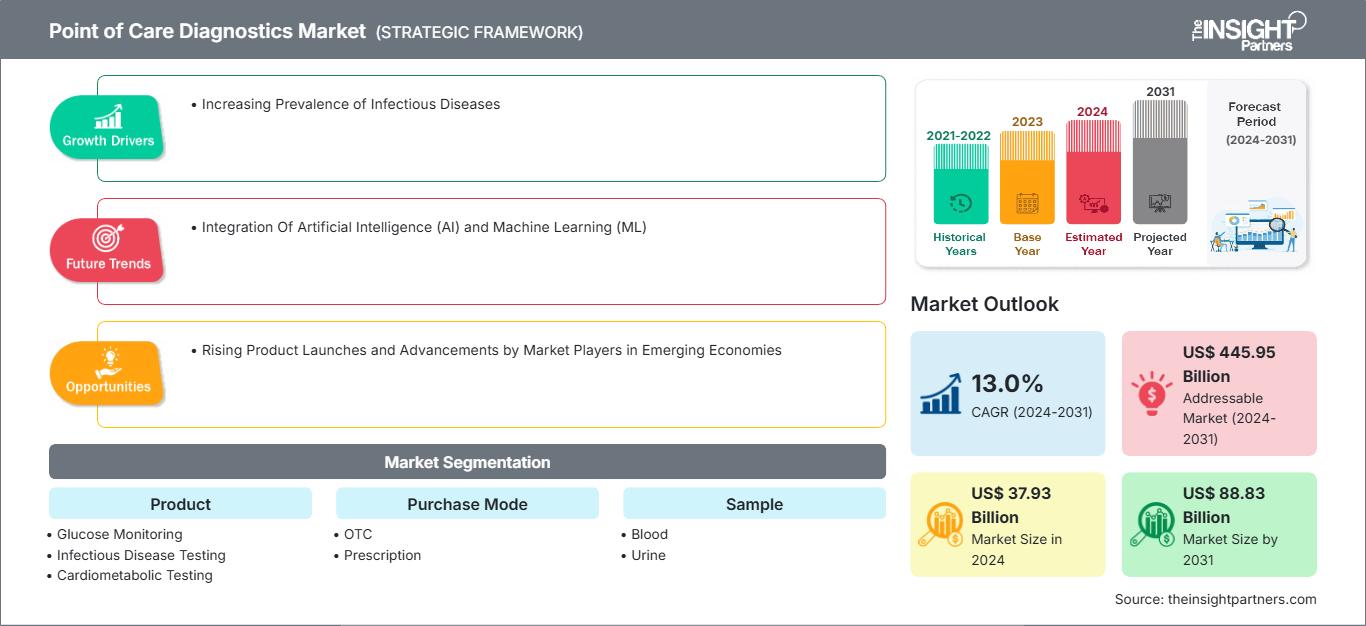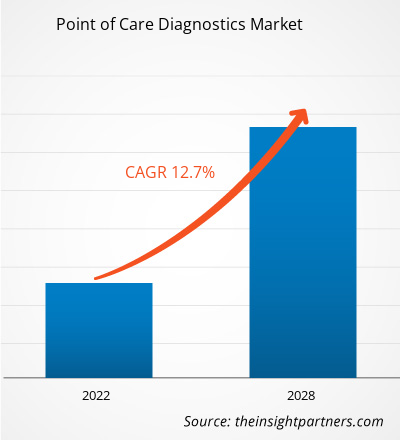预计到 2031 年,即时诊断市场规模将从 2024 年的 379.3 亿美元增至 888.3 亿美元。预计该市场在 2024 年至 2031 年期间的复合年增长率为 13.0%。人工智能 (AI) 和机器学习 (ML) 的融合可能会在未来几年为市场带来新的趋势。
即时诊断市场分析
即时诊断 (POC) 市场的增长是由传染病日益流行的推动的,这增加了对快速准确诊断解决方案的需求。技术进步以及人工智能和机器学习的融合正在提高测试方法的效率和准确性。此外,对自我诊断工具的日益增长的需求以及向分散式医疗保健的转变预计将为未来的市场扩张创造机会。然而,诸如即时检测 (POC) 与集中式实验室方法之间的标准化等挑战,影响着这些诊断解决方案的广泛应用。
即时诊断市场概览
即时诊断 (POC) 市场正在不断发展,对即时准确诊断解决方案的需求日益增长。POC 检测在患者护理点附近进行,可快速获得结果,从而有助于临床环境中的及时决策。这种检测需求受到传染病和慢性病日益流行的影响,这些疾病需要快速诊断能力。
便携式诊断设备和集成数字健康解决方案等创新提高了检测效率和可及性。向分散式医疗模式的转变促使患者和医疗保健提供者寻求更便捷的检测方式,这些方式可以在传统实验室环境之外进行。
总体而言,在快速检测解决方案需求和诊断技术持续进步的推动下,POC 诊断市场有望实现大幅增长。
自定义此报告以满足您的要求
您将免费获得任何报告的定制,包括本报告的部分内容,或国家级分析、Excel 数据包,以及为初创企业和大学提供超值优惠和折扣
即时诊断市场: 战略洞察

-
获取本报告的主要市场趋势。这个免费样本将包括数据分析,从市场趋势到估计和预测。
即时诊断市场驱动因素与机遇
关键产品发布与发展
自即时诊断推出以来,其数量不断增加。随着旨在在距离患者尽可能近的医疗机构提供廉价医疗服务的新产品的推出,预计这一数量还将增长。新产品或新技术的推出旨在提高设备的有效性,并逐步提高分析性能。即时诊断市场的增长得益于用于进行分子检测的新设备的推出。近年来推出的新设备包括:
• 2023 年 6 月,Sysmex Corporation 在欧洲推出了一款即时诊断系统,用于检测抗菌药物敏感性。该系统使用疑似患有尿路感染的患者尿液样本来识别细菌的存在与否,并评估抗菌药物的有效性。
• 2023年1月,西普拉有限公司 (Cipla Limited) 推出了即时诊断设备 Cippoint。该设备可提供心脏标志物、传染病、糖尿病、生育能力、甲状腺功能、炎症、代谢标志物和凝血标志物等检测参数。该设备已获得 CE IVD 认证,这意味着该设备符合欧洲体外诊断设备指令 (IVD) 的要求,可提供可靠的检测解决方案。
• 2021 年 7 月,QuantuMDx 推出了 Q-POC 快速 PCR 即时诊断系统,其首款检测产品为 SARS-CoV-2 检测试剂,现已获得 CE-IVD 认证,可根据体外诊断指令 (98/79/EC) 在欧洲使用。
因此,市场参与者不断推出新产品,推动了 POC 诊断市场的增长。
新兴经济体市场参与者推出新产品并取得进展
为了扩展业务,市场参与者正专注于印度、中国和巴西等新兴国家,因为这些国家有大量人口患有艾滋病毒和其他传染病。根据新闻信息局 2023 年的报告,印度约有 250 万人感染艾滋病毒,患病率为 0.2%,印度每年报告 66,400 例新的艾滋病毒感染病例。越来越多的产品上市表明,先进的即时诊断试剂盒的应用前景广阔。2022年1月,Mylab在印度推出了CoviSwift即时诊断解决方案,该解决方案可用于小型实验室、医院实验室、机场和乡村,并可在任何地方进行高通量、符合黄金标准的检测。该解决方案包含CoviSwift检测试剂盒和Compact-Q检测仪,可在40分钟内处理16个样本,比传统的RT-PCR检测快约4倍,同时保持高精度。
纳米技术和基因组学的进步正在增加医疗保健领域对诊断的需求,鼓励引入更多即时诊断系统,并促进向个性化医疗的转变。新兴国家在传染病检测、分子肿瘤学和药物基因组学方面也迎来了新的机遇。纳米材料和纳米技术的发展促进了即时诊断平台的进步,这些平台应用于比色法、光学法、电化学法、磁法和催化法。即时诊断平台用于检测核酸、蛋白质、农药、病毒、疾病诊断中的生物标志物,甚至重金属种类。因此,新兴国家不断涌现的产品发布和技术进步预计将在预测期内为即时诊断市场提供充足的增长机会。
即时诊断市场报告细分分析
促成即时诊断市场分析的关键细分领域包括产品、购买模式、样本、最终用户和地域。
- 根据产品,即时诊断市场细分为血糖监测、传染病检测、心脏代谢检测、妊娠和生育检测、凝血功能检测、肿瘤/癌症标志物检测、胆固醇检测、尿液分析检测、血液学检测、甲状腺检测等。 2024年,血糖监测细分市场占据了即时诊断市场的最大份额,预计在2024年至2031年期间将实现显著的复合年增长率。
- 按购买方式,市场分为非处方药 (OTC) 和处方药。2024年,处方药细分市场占据了即时诊断市场的最大份额。
- 按样本,即时诊断市场细分为血液、尿液和其他。2024年,血液细分市场占据了即时诊断市场的最大份额,预计在2024年至2031年期间将实现显著的复合年增长率。
- 按最终用户细分,即时诊断市场细分为医疗机构、家庭护理和其他。 2024 年,医疗机构部门占据了即时诊断市场的最大份额,预计 2024 年至 2031 年期间的复合年增长率将显著提升。
按地区划分的即时诊断市场份额分析
即时诊断市场报告的地理范围主要分为五大区域:北美、欧洲、亚太地区、中东和非洲以及南美和中美。北美地区凭借其强大的医疗基础设施和早期采用的创新诊断技术引领市场。加拿大在最大的医疗器械市场中排名第八。根据加拿大政府 2023 年的报告,糖尿病的患病率正在显著上升。该国约有 370 万人口(占总人口的 9.4%)患有糖尿病或糖尿病前期疾病。该协会表示,每三分钟就有一人被诊断出患有糖尿病。此外,根据加拿大政府发布的一份报告,自2022年以来,加拿大的艾滋病毒感染率增长了约35.2%,2023年报告了2,434例新的艾滋病毒病例。加拿大癌症协会的数据显示,癌症是该国死亡的主要原因之一,2023年约30%的死亡病例是由癌症引起的。肺癌、乳腺癌、结直肠癌和前列腺癌是确诊和死亡的主要原因,占比超过46%。
2023年7月,Fortis Life Sciences, LLC收购了总部位于多伦多的International Point of Care, Inc. (IPOC)。IPOC开发和生产用于诊断的组件,包括冻干试剂、膜、重组蛋白和对照品。通过此次收购,Fortis可以为客户提供可定制的端到端解决方案,以推进其免疫诊断和分子诊断产品的发展。 IPOC 近期扩建的 36,000 平方英尺工厂是 Fortis 在北美第三个符合 GMP 和 ISO 13485 标准的生产基地。因此,癌症发病率的飙升、其他疾病发病率的上升以及战略合作推动了该国即时诊断市场的增长。
即时诊断市场区域洞察
The Insight Partners 的分析师已详尽阐述了预测期内影响即时诊断市场的区域趋势和因素。本节还讨论了北美、欧洲、亚太地区、中东和非洲以及南美和中美洲的即时诊断市场细分和地域分布。
即时诊断市场报告范围
| 报告属性 | 细节 |
|---|---|
| 市场规模 2024 | US$ 37.93 Billion |
| 市场规模 2031 | US$ 88.83 Billion |
| 全球复合年增长率 (2024 - 2031) | 13.0% |
| 历史数据 | 2021-2022 |
| 预测期 | 2024-2031 |
| 涵盖的领域 |
By 产品
|
| 覆盖地区和国家 |
北美
|
| 市场领导者和主要公司简介 |
|
即时诊断市场参与者密度:了解其对业务动态的影响
即时诊断市场正在快速增长,这得益于终端用户需求的不断增长,而这些需求的驱动因素包括消费者偏好的演变、技术进步以及对产品优势的认知度的提升。随着需求的增长,企业正在扩展产品线,不断创新以满足消费者需求,并抓住新兴趋势,从而进一步推动市场增长。

- 获取 即时诊断市场 主要参与者概述
即时诊断市场新闻及最新发展
即时诊断市场评估通过收集一手和二手研究后的定性和定量数据进行,这些数据包括重要的公司出版物、协会数据和数据库。以下列出了该市场的一些关键发展:
- 体外诊断领域的领导者生物梅里埃公司宣布已达成协议,收购 SpinChip Diagnostics ASA(“SpinChip”)。这家私营的挪威诊断公司开发了一个颠覆性的免疫测定诊断平台。这款小型台式分析仪适用于近患者检测,因为它可以在 10 分钟内从全血样本中得出结果,并且具有与实验室仪器相同的高灵敏度性能。生物梅里埃自2024年3月起持有SpinChip的少数股权。(来源:生物梅里埃,公司网站,2025年1月)罗氏宣布,在获得所有必要的反垄断和监管批准后,已完成对LumiraDx即时诊断技术的收购。罗氏将把该公司的多检测即时诊断平台以及相关的研发、运营和商业基地整合到其全球组织架构中。 (来源:罗氏公司,公司网站,2024 年 7 月)。
即时诊断市场报告覆盖范围和可交付成果
《即时诊断市场规模和预测(2021-2031)》报告对市场进行了详细的分析,涵盖以下领域:
- 即时诊断市场规模以及全球、区域和国家/地区范围内涵盖的所有关键细分市场的预测
- 即时诊断市场趋势以及市场动态,例如驱动因素、限制因素和关键机遇
- 详细的 PEST 和 SWOT 分析
- 数字 PCR 和实时 PCR 市场分析,涵盖关键市场趋势、全球和区域框架、主要参与者、法规和最新市场发展
- 行业格局和竞争分析,涵盖市场集中度、热图分析、知名参与者以及数字 PCR 和实时 PCR 的最新发展市场
- 详细的公司简介
- 历史分析(2 年)、基准年、预测(7 年)及复合年增长率
- PEST和SWOT分析
- 市场规模、价值/数量 - 全球、区域、国家
- 行业和竞争格局
- Excel 数据集
近期报告
客户评价
购买理由
- 明智的决策
- 了解市场动态
- 竞争分析
- 客户洞察
- 市场预测
- 风险规避
- 战略规划
- 投资论证
- 识别新兴市场
- 优化营销策略
- 提升运营效率
- 顺应监管趋势






















 获取免费样品 - 即时诊断市场
获取免费样品 - 即时诊断市场